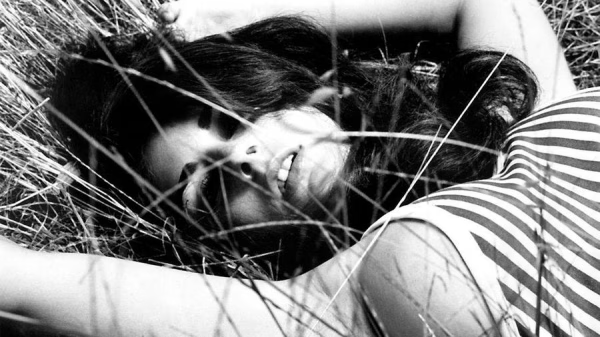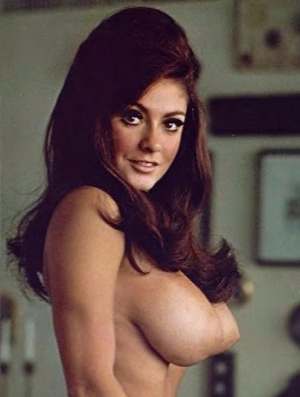Eve Meyer: The Pin-Up Icon and Film Producer
From Southern Beauty to Glamorous Starlet
Eve Meyer, born Evelyn Eugene Turner on December 13, 1928, in Atlanta, Georgia, embodied the essence of mid-century glamour. Before she became known as a dazzling pin-up icon and film producer, she was a Southern girl with an ambitious spirit and striking beauty.
From her earliest years, Eve stood out. With her blue eyes, golden blonde hair, and statuesque figure, she seemed destined for the spotlight. As a teenager in post-war America, she embraced the era’s love of curves and femininity, soon stepping into the world of modeling.
By the early 1950s, she had become a sought-after pin-up model, appearing in calendars, men’s magazines, and photo spreads that celebrated her radiant figure. Her look perfectly captured the vintage ideal of sensual yet approachable glamour. She was frequently described as “impossibly built,” a phrase that highlighted her extraordinary curves and which would follow her throughout her career.
Her crowning achievement in modeling came in June 1955, when she was chosen as Playboy Magazine’s Playmate of the Month. The entire pictorial — photographed by her then-husband Russ Meyer — catapulted her into the national spotlight and cemented her as one of the decade’s most iconic beauties.
Characteristics That Defined Eve Meyer
To vintage film and glamour enthusiasts, Eve’s attributes were legendary. Her appearance and persona were recorded in various biographies, fan magazines, and production notes:
- Full Name: Evelyn Eugene Turner
- Stage Name: Eve Meyer
- Date of Birth: December 13, 1928
- Birthplace: Atlanta, Georgia, USA
- Eye Color: Blue
- Hair Color: Blonde
- Height: 5 ft 7 in (170 cm)
- Measurements: Reported as 38-24-36, the quintessential 1950s pin-up silhouette
- Distinctive Traits: Warm Southern charm, commanding presence, confidence both in front of and behind the camera
- Playboy Appearance: Playmate of the Month, June 1955
- Marriage: Russ Meyer (1952–1969)
- Children: None known
- Profession(s): Pin-up model, actress, producer
“She had a body that could stop traffic,” one admirer remarked, “but it was her confidence and business savvy that truly set her apart.”
Muse, Actress, and Hollywood Visionary
When Eve Meyer married Russ Meyer in 1952, she became more than just a wife — she became his muse, his on-screen star, and eventually his most vital collaborator. Their partnership was one of cinema’s most fascinating unions of glamour and grit. Eve embodied the archetypal beauty of the 1950s, yet she was also a strategist, organizer, and creative force who shaped the style of her husband’s films.
As one critic noted, “Eve Meyer pumped life into Russ Meyer’s output — she was the heartbeat of his films, both in front of the camera and behind it.”
First Steps into Acting

Eve’s film debut was uncredited — a brief appearance in the Dean Martin and Jerry Lewis comedy Artists and Models (1955). Though just a glimpse, it marked the beginning of her screen presence. Her first credited role came in Operation Dames (1959), where she played Lorry Evering, a Red Cross worker caught in the turmoil of the Korean War. This performance showcased her ability to bring both sensuality and strength to the screen.
But it was Eve and the Handyman (1961) — directed by Russ Meyer himself — that marked her true star turn. Eve not only starred as the leading lady, she also styled her own hair and makeup, cooked meals for the crew, and helped keep production running smoothly. Reflecting on this period, she later confessed:
“I never worked so hard in my life.”
The film, though low-budget, was groundbreaking. Roger Ebert highlighted her unforgettable pinball machine dance, calling it a witty mix of eroticism and humor. Critics and fans alike recognized that Eve wasn’t just an actress — she was the defining presence of a new kind of cinema.





The Birth of the “Russ Meyer Woman”
Through Eve and the Handyman, Eve inspired what would become known as the “Russ Meyer Woman” — a strong, voluptuous, sexually confident character who dominated the screen. A source explained:
“For Eve Meyer is the first ‘Russ Meyer Woman.’ She showed Russ how to present a woman who looked like she wanted to be wanted — and more importantly, wanted the audience to know that she knew they knew she wanted to be wanted.”
This archetype became central to Meyer’s work and would influence cult cinema for decades.
Complete Filmography of Eve Meyer
As Actress:
- Artists and Models (1955) – Uncredited
- Operation Dames (1959) – Lorry Evering
- Eve and the Handyman (1961) – Eve / multiple roles
Eve Meyer’s Work as a Film Producer
After her acting stint, Eve increasingly stepped into the role of producer, handling business, organization, and financing — the backbone of Russ Meyer’s productions. She was listed variously as producer, executive producer, or associate producer on many of his films. Her influence was enormous: she selected locations, oversaw casting, and managed budgets, ensuring Meyer could focus on his eccentric and groundbreaking visual style.
Her credits as producer include nearly all of Russ Meyer’s key works from the 1960s and early 1970s:
- Lorna (1964) – Producer
- Mudhoney (1965) – Producer
- Faster, Pussycat! Kill! Kill! (1965) – Producer
- Motorpsycho (1965) – Producer
- Mondo Topless (1966) – Producer
- Common Law Cabin (1967) – Producer
- Good Morning and… Goodbye! (1967) – Producer
- Finders Keepers, Lovers Weepers! (1968) – Producer
- Vixen! (1968) – Producer
- Cherry, Harry & Raquel! (1970) – Producer
- Beyond the Valley of the Dolls (1970) – Executive Producer
- The Seven Minutes (1971) – Associate Producer
- The Jesus Trip (1971) – Producer
- Black Snake (1973) – Producer
Even after their divorce in 1969, Eve continued to produce Russ Meyer’s films — a testament to her professional dedication and influence. Some critics argue that his films lost their spark after their separation, suggesting that Eve’s presence had been his secret weapon all along.

Legacy, Tragedy, and Eternal Glamour
By the late 1960s and early 1970s, Eve Meyer had transitioned from on-screen starlet to one of the most influential female producers in cult cinema. Even after her 1969 divorce from Russ Meyer, she remained deeply involved in his productions, credited as producer on films including Vixen! (1968), Cherry, Harry & Raquel! (1970), and the boundary-breaking Beyond the Valley of the Dolls (1970).
But Eve’s talents were not limited to the Russ Meyer universe. Those who knew her described her as a sharp businesswoman with a head for numbers, a gift for logistics, and the ability to keep chaotic sets running smoothly. In an industry dominated by men, she carved out a rare role as a woman in power behind the camera — all while maintaining her aura of 1950s Hollywood glamour.
“She wasn’t just a pin-up; she was a pioneer,” a contemporary later observed. “Without Eve Meyer, there would be no Russ Meyer as we know him.”
A Life Cut Tragically Short
On March 27, 1977, Eve Meyer boarded Pan Am Flight 1736 en route to the Canary Islands. The Boeing 747 had been diverted to Los Rodeos Airport (now Tenerife North Airport) due to a terrorist bomb explosion at Gran Canaria Airport. The airport quickly became overcrowded, and heavy fog reduced visibility to near zero.
In those conditions, tragedy struck. As Pan Am 1736 prepared for departure, KLM Flight 4805 attempted to take off without clearance. The two jumbo jets collided on the runway in what remains the deadliest accident in aviation history. All 248 people aboard the KLM flight perished, along with 335 of the 396 passengers and crew on the Pan Am flight. Among the victims was Eve Meyer, just 49 years old.
Her untimely death stunned those who admired her. For many, it seemed unthinkable that a woman so vibrant, glamorous, and influential could be taken in such a sudden, catastrophic way.

Legacy of a Glamour Pioneer
Today, Eve Meyer’s name may not be as widely recognized as some of her contemporaries, but among vintage film lovers and cult cinema enthusiasts, her influence is undeniable. She was:
- The First Russ Meyer Woman – inspiring a new kind of on-screen femininity: bold, sensual, and in command.
- A Groundbreaking Producer – one of the very few women in the 1960s to hold significant production power in Hollywood.
- A Vintage Icon – remembered for her Playboy spread, her acting in Eve and the Handyman, and her timeless pin-up appeal.
- A Tragic Figure – her life cut short in an aviation disaster that reshaped air safety worldwide.
As she famously declared in Eve and the Handyman:
“The biggest catch in life, my friends, is a happy ending.”
Though her ending was tragic, her legacy remains a happy one for those who cherish the golden age of glamour, vintage cinema, and trailblazing women in film.

Sources & Further Reading
To create the most comprehensive online profile of Eve Meyer, the following references were consulted:
- Playboy Magazine Archive – June 1955 Issue, Playmate of the Month: Eve Meyer – https://www.playboy.com
- IMDb – Eve Meyer Filmography – https://www.imdb.com/name/nm0583384/
- Roger Ebert Review Archive – Commentary on Eve and the Handyman – https://www.rogerebert.com
- Turner Classic Movies (TCM) – Eve Meyer’s credits – https://www.tcm.com
- National Transportation Safety Board – Tenerife Disaster Report – https://www.ntsb.gov
- Find A Grave: Eve Meyer Memorial – https://www.findagrave.com/memorial/7393/eve-meyer
- Hollywood Forever Blog – Profiles of Classic Playboy Models – https://hollywoodforever.com




































